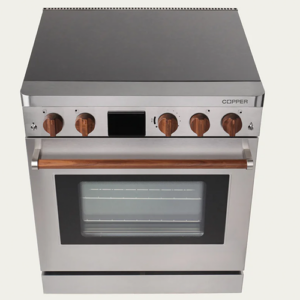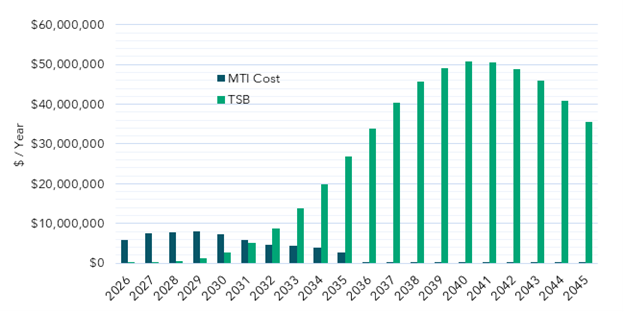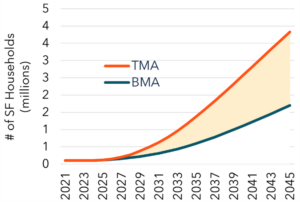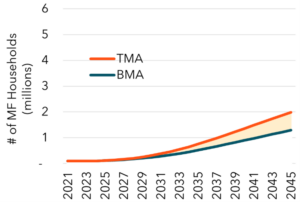The Induction Cooking Market Transformation Initiative (MTI) focuses on electric cooktops and all-electric ranges using either induction or ENERGY STAR-rated radiant electric technology. While the radiant products are included at this time, the main focus of this MTI is induction cooking appliances. Resistance coil products are not included in this MTI.
This product definition includes freestanding electric ranges, which can be installed between cabinets, or stand alone as well as slide-in electric ranges, which can only be installed between cabinets. Freestanding ranges typically locate cooking controls in an elevated panel at the back of the appliance, whereas slide-in ranges typically put controls in the front.


This definition also includes 120V and 240V standalone electric cooktops designed for permanent installation in a countertop, as seen below.


Induction cooktops and ranges use electromagnetic induction in the cooktop portions of the technology to heat cookware directly. Induction cooking saves energy through instant, direct, and efficient heat transfer, and provides precise temperature control.
Modern, efficient electric cooking appliances, including induction cooktops and ranges, offer improved indoor air quality and safety, cooking performance, energy savings, and greenhouse gas (GHG) emissions reduction when compared to gas-fueled stoves and ranges found in most California homes and apartments. While ENERGY STAR-rated radiant appliances offer similar efficiency and GHG emission reduction benefits, induction cooking provides a superior cooking experience over radiant products, as well as significant safety and health benefits.

Induction appliances use electricity to create electromagnetic fields that induce a current and heat cookware directly. Heat is generated by allowing a high frequency, alternating current to flow through a tightly wound coil of wire which generates a rapidly changing magnetic field at the surface of the cooktop.
The resulting heat is only generated in a pot or pan containing ferromagnetic material. Since non-magnetic materials do not respond to the magnetic fields, nearly all energy generated is transferred to the cooking vessel. This technology eliminates the need for an open flame or exposed heating elements, making it both safe and more efficient.
Yes, induction and radiant cooktops remove gas, a key source of indoor pollutants. A 2013 meta-analysis found that children living in homes with gas cooking had a significant increased risk of developing asthma, with a 42% greater chance than their peers without gas.
In California, where about 65% of homes have gas cooking appliances, we can estimate a significant number of individuals at risk. Since children under the age of 18 account for about 22% of California’s population, this translates to around 5.5 million children with a 42% increased risk of asthma compared to their peers without gas cooking. (1)
Furthermore, negative indoor air quality is generally inversely proportional to the size of the dwelling unit, meaning that smaller homes are at risk of bigger impacts. This is particularly relevant for multifamily dwelling units, which also suffer from shared exposure from others cooking with gas in the building. These constraints may create an additional indoor air quality burden for Environmental Social Justice communities in multifamily units.
(1.) Lin W, Brunekreef B, Gehring U. Meta – analysis of the effects of indoor nitrogen dioxide and gas cooking on asthma and wheeze in children. Int J Epidemiol. 2013 Dec;42(6):1724 -37. doi: 10.1093/ije/dyt150. Epub 2013 Aug 20. PMID: 23962958.
Limited electric panel upgrades are a barrier to induction cooking installations when switching from gas cooktops and ranges to induction cooking.
To overcome the cost of panel upgrades, this MTI is investigating opportunities for 120V induction appliances that utilize a battery to provide additional energy supply to the appliance when needed. Battery-equipped products are an emerging technology in this marketplace, but will be a key solution for building owners looking to electrify cooking appliances with minimal expense.

Market transformation (MT) works to remove structural barriers and enact strategic interventions to create lasting change in a market. MT theory is the broad conceptualization of how best to address those barriers in order to accelerate adoption of a targeted energy efficient technology or practice. The changes created by strategic interventions grow market share and pull adoption forward in time.
Figure 1 below shows the area between the Baseline Market Adoption and Total Market Adoption S-curves. The differential is the increase resulting from MT activities that deliver cost-effective energy efficiency, greenhouse gas (GHG) reductions, or other identified benefits.

Market transformation works by removing barriers through a variety of interventions. The logic model expresses a variety of moving – and dependent – parts into a single model. A carefully conceived initiative logic model provides a tool for expressing and tracking program logic and is vital to successful market transformation.
Let’s take induction cooktops as an example. Our team identified the lack of an ENERGY STAR® specification for cooking products as an opportunity for transforming the market. With more informative labeling, consumers would be able to understand the efficiency benefits of induction technologies and more easily choose the more efficient option.
A logic model not only identifies this barrier, but also any opportunities and interventions to remove it. The lack of an ENERGY STAR specification is an opportunity to leverage strategic interventions by working with the ENERGY STAR program’s specifications and collaborating with manufacturers to ensure proper labeling of products. The projected outcomes of those interventions are included in the logic model as well. For example, this logic model seeks ENERGY STAR adoption of a new specification within three to five years.
CalMTA uses a stage gate model in its Market Transformation Initiatives (MTI) strategy and program creation. A three-phase process with end-phase stage gates (shown below) helps manage program risk, maximize the use of resources, and increase transparency in our work. Learn more about the process here.
Advancement Plan approval is the stage gate that culminates Phase I: Concept Development and the plan includes a preliminary logic model. After the research and investigation described in the Advancement Plan is complete, an updated logic model is developed for inclusion in the Phase II stage gate deliverable, the MTI Plan. Click the link below to access the draft Induction Cooking draft logic model.
Watch the Idea to Initiative Part 1 section of the Sept. 19 Market Transformation Advisory Board meeting to learn more about the Market Transformation Theory and Logic Model for the Induction Cooking Initiative.
Market transformation is a strategic process of intervening in a market to create lasting change. CalMTA developed a Market Transformation Initiative Evaluation Framework to lay out how we will track and evaluate the impact and cost-effectiveness of our MTIs. For each of our initiatives we develop a theory of market transformation and logic model that identifies expected short-term, medium-term, and long-term market outcomes resulting from strategic market interventions. Third-party evaluators will evaluate market progress based on the Market Progress Indicators and Milestones developed for each MTI.
An Outcome is the market’s response to one or more MTI’s strategic market interventions. That people buy more room heat pumps may be the end goal, but these are long-term initiatives that must be assessed over time. The end goal that doesn’t track the progress of each market intervention in the short-, mid- and long-term. Some Outcomes will be realistic in a few years, while others may take a decade to realize. For the Room Heat Pumps MTI, there are 21 Outcomes showing in the Logic Model that we would expect to see from our work.
MPIs are metrics that correspond with logic model outcomes and are used to track market progress.
Milestones are the specific expected quantitative or empirical achievements, including timing, that correspond with certain MPIs. While MPIs are used to track market progress, Milestones track specific achievements. Together, these metrics allow CalMTA assess MTI performance and identify areas that are performing differently than expected, so that the MTI can make timely course corrections, as appropriate.
CalMTA has identified several different strategic interventions necessary for transforming the market for RHPs. One of those is to influence manufacturer development of window heat pumps that meet the needs of the California market through technology challenges, demand aggregation, and ongoing manufacturer engagement. The table below shows the Outcomes we seek to achieve in the short-, medium-, and long-term time frames, along with the MPIs and Milestones we’ll use to track our impact. The Milestones will show evidence of change in the market.
Outcome | Time | Market Progress Indicators | Market Milestones |
| Manufacturers respond to specification with product plans for California-suitable products | Short (1-2 years) | Number of manufacturers engaging with CalMTA | Two manufacturers engage with CalMTA Tech Challenge by the end of 2026 |
| Multifamily building owners value product and being to purchase it | Short (1-2 years) | Number of units covered by bulk purchase agreements | Agreements in place by the end of 2026 for multifamily building owners to purchase at least 10,000 units going forward |
Availability of products that fit slider and casement windows and California-suitable temperature performance grows. Some products are available with air filtration capability. | Medium (3-5 years) | Number of Type 2 and Type 3 products for sliding and casement windows available for purchase | Three RHP Type 2 or Type 3 products for sliding and casement windows become available for purchase by 2030 |
Medium (3-5 years) | Number of RHP products with air filtration capabilities available for purchase | Three RHP products with air filtration available by 2030 |
Watch the Idea to Initiative Part 2 section of the Oct. 25 Market Transformation Advisory Board meeting to learn more about the Market Progress Indicators for the Induction Cooking Initiative.
The Total System Benefit (TSB) is the dollar-value metric that measures energy savings, grid benefits and reliability, and greenhouse gas (GHG) impacts. In 2021 the California Public Utilities Commission (CPUC) announced its intention to use this approach to evaluate the State’s energy efficiency programs to better align them with GHG emissions reduction, support for customer equity, and long-term grid stability. In the past, the CPUC’s dollar-value metrics had been based on kilowatt-hours, kilowatts, and therms, but this new TSB approach encourages programs to target high-value load reductions without directly comparing one fuel source against another (i.e., gas vs. electricity). It focuses on the benefits to the “total system” – including residents’ health and environmental concerns – rather than one particular fuel source. The CPUC officially adopted this new approach in 2024.
As California’s first Market Transformation Administrator, CalMTA is working to create energy efficiency initiatives that will transform the market. A crucial part of that work is understanding just how much a particular initiative will benefit California. While our market transformation initiatives (MTIs) seek to generate energy savings and related benefits by accelerating and increasing market adoption of energy-efficient technologies and practices, we need to evaluate those MTIs carefully.
TSB helps us measure our MTIs’ impact. Carefully estimating the energy impacts and cost-effectiveness of an MTI is crucial to understanding it and its value to Californians. Good estimates require developing a forecasting model that uses a set of inputs based on well-documented sources, methods, and assumptions. Getting the TSB right is as much about good research as it is about good math.
The Induction Cooking MTI will deliver an estimated $537 million in TSB from 2024 to 2045. Most of these benefits come from GHG emission reductions associated with changing over from gas to electric cooking appliances. These abated emissions are worth more than $600 million when using Total Resource Cost (TRC) to calculate benefits, and substantially more when calculated using Societal Cost Tests, due to a much lower discount rate for that test. There are negative grid TSB benefits largely due to the impact of fuel substitution as induction and efficient electric cooktops are projected to replace natural gas units. Overall, the initiative creates $36 million in net energy benefits.

Not only do our initiatives need to demonstrate a beneficial TSB; they need to be cost effective. Cost-effectiveness is measured by comparing the initiative’s benefits with the costs. Various tests are used to provide different information about the impacts of the initiative from distinct vantage points. Together, these tests provide a comprehensive picture of the initiative’s cost-effectiveness:
The TRC and SCT cost tests help to answer whether efficiency is cost-effective overall. The PAC helps to answer whether the selection of measures and design of the program is balanced from the utility perspective. Collectively, these tests reveal the cost-effectiveness from the perspective of various stakeholders including program participants, utilities or California as a whole.
The initiative is cost-effective under all test perspectives.
| TRC | PAC | SCT |
| 1.12 | 14.36 | 3.04 |
More details about cost-effectiveness are available in Appendix B of the Induction Cooking MTI Plan.
CalMTA has forecasted the baseline market adoption (BMA) and total market adoption (TMA) of Induction Cooking. BMA represents the expected “naturally occurring” market adoption, considering current and expected market, and regulatory and technological trends. Total Market Adoption (TMA) includes the additional adoption resulting from strategic interventions detailed in this MTI plan.


Watch the Idea to Initiative Part 3 section of the Nov. 21 Market Transformation Advisory Board meeting to learn more about the Total System Benefit and Cost Effectiveness for the Induction Cooking Initiative.
CalMTA seeks to support statewide priorities on environmental and social justice and ensure MTI outcomes reflect the needs and desires of the communities they benefit. To this end, we are working with experts in the California market on equity program development and implementation. Learn more about CalMTA’s Equity Lens.
The Induction Cooking MTI addresses both cost and product availability, which will serve all consumers, but especially ESJ communities. Several interventions will work to overcome specific barriers faced by multifamily and small residential housing, which predominantly serve limited income households. Key benefits include:
The following strategic interventions have an equity consideration:

The California Market Transformation Administrator (CalMTA) develops and manages market transformation initiatives in the state to reduce energy use and reduce greenhouse gas (GHG) emissions.


CalMTA follows a rigorous process for reviewing, scoring, and then developing relevant, timely market transformation initiatives. The process supports market transformation initiative creation from concept to program development to market deployment, as well as the eventual exiting of the market.

Learn more about CalMTA’s planning and research on energy efficient technologies and our work to build California’s market transformation portfolio, and access quarterly and annual progress reports.
Want to learn more? Join our mailing list to stay informed about upcoming meetings and events, RFI and RFP announcements, and more.
We welcome your questions and suggestions.
Have questions or comments about CalMTA?
Use our contact form to connect with us, or reach out to:
CalMTA
Resource Innovations
719 Main Street, Suite A
Half Moon Bay, CA, 94019
(888) 217-0217
All Advisory Board meetings are open for public comment. If you’re unable to share your thoughts during an MTAB meeting, access our comment form to to provide your opinion.
Want to learn more? Sign up for our mailing list to receive twice-monthly updates about upcoming events, including Advisory Board meetings, informational webinars, important RFI deadlines, and more.